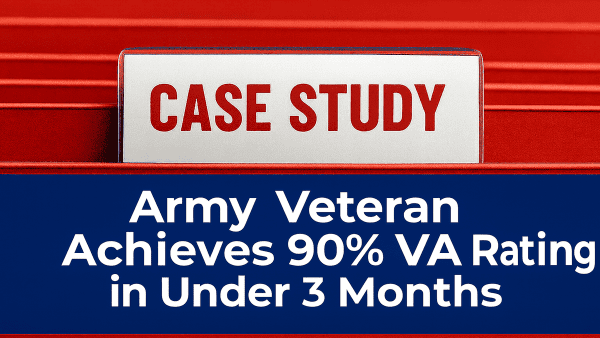Looking for Expert-Level VA Claim Answers?📱Call Us Now! 737-295-2226
If you feel like your VA disability rating doesn’t truly reflect the severity of your condition, you’re not alone.
Many veterans struggle due to outdated ratings, lack of medical evidence, or missed opportunities to file for additional conditions.
The good news? There are strategies that may support you in working toward increasing your VA disability rating and maximizing your benefits.
In this post, we’ll break down the 6 BEST ways to increase your VA disability rating and work toward the rating you rightfully deserve.
Let’s get started!
Table of Contents
Summary of Key Points
- Raising VA disability ratings requires strong medical evidence, accurate documentation, and a clear understanding of how the VA evaluates service-connected conditions.
- Veterans can use VA Form 21-526EZ to file a new claim to file a new claim or request an increase in their existing disability rating.
- Understanding VA math, filing for secondary conditions, and considering TDIU can all help maximize your benefits.

6 BEST Ways to Increase Your VA Disability Rating
- Gather strong medical evidence
- File a simple VA disability increase claim
- File a claim for a presumptive condition
- Consider filing for secondary conditions
- File an appeal to a VA claim decision
- File for total disability based on individual unemployability (TDIU)
Gather Strong Medical Evidence
One of the most critical steps in obtaining an increase in VA disability is providing comprehensive medical documentation.
The VA evaluates claims based on the severity of the service-connected condition, so ensure you have:
- Recent medical records and necessary evidence outlining the progression of your disability.
- Doctor statements detailing how your condition affects daily activities and work.
- A personal symptom journal tracking pain levels, mobility issues, and other limitations.
Generally, you need to provide the VA with medical evidence that shows how your disability symptoms have worsened in terms of frequency (how often), severity (how bad), and duration (how long).
File a VA Disability Increase Claim
Filing a simple increase claim to increase compensation for conditions already service-connected and rated at 0% or higher is the easiest way to raise your VA disability rating.
Simple VA disability increase claims filed as Fully Developed Claims (FDC) are often processed faster than other claim types.
Here’s how:
- Complete VA Form 21-526EZ to request a rating increase.
- Attach updated medical records, doctor statements, and medical test results.
- If applicable, include evidence of how your disability now affects your ability to work.
Related Posts:
File a VA Claim for Presumptive Conditions
The PACT Act expanded VA healthcare and disability benefits for veterans exposed to toxic substances, such as burn pits and Agent Orange, making it easier to qualify for presumptive conditions.
Certain conditions are automatically presumed to be service-connected based on your military service, location, or exposure to hazardous materials.
If you have a condition on the VA’s presumptive list, you may qualify for VA disability compensation without proving a direct service connection.
Read more: List of New VA Presumptive Conditions
Consider Filing for Secondary Conditions
If you’re asking, “How can you increase a 0% VA disability rating?” or increase any existing VA rating, consider filing for VA secondary conditions.
Many veterans suffer from VA secondary conditions, which develop due to a primary service-connected disability.
While not guaranteed, secondary conditions may increase your total VA monthly compensation.
Common examples of VA secondary conditions include:
- A service-connected knee injury leads to back pain
- Service-connected PTSD causes sleep disorders or migraines
- Service-connected diabetes leading to neuropathy
- Service-connected Tinnitus causes anxiety or depression
If you suspect you have a secondary condition, speak to your doctor about obtaining medical documentation linking it to your service-connected disability.
See More: VA TDIU Approval Rate
File an Appeal to a VA Claim Decision
If your original claim was denied, you can file an appeal, especially if you feel you rightfully deserve VA benefits.
Your appeal options are:
- File a Higher-Level Review (HLR) to ask for a higher-level reviewer to review your case. (You can’t submit new evidence.)
- File a Supplemental Claim if you have new and relevant evidence that the VA didn’t have when they reviewed your case.
- Appeal to the Board of Veterans’ Appeals to have a Veterans Law Judge review your case.
See More: VA Disability Appeal Success Rates
File for Total Disability Based on Individual Unemployability (TDIU)
You may qualify for TDIU if your service-connected disability prevents you from securing and maintaining substantial gainful employment.
Even if your disability rating doesn’t reach 100%, TDIU allows you to receive VA disability compensation at the 100% rate if your condition significantly limits your ability to work.
To qualify for TDIU, you must meet one of two primary criteria:
- Have a single service-connected disability rated at 60% or higher, or
- Have two or more service-connected disabilities with at least one rated at 40% and a combined rating of 70% or higher

How to Prove Your Service-Connected Disability Worsened
If your service-connected disability has worsened, you’ll need to provide current medical evidence that shows the increased severity of your condition and that the higher ratable symptoms are met.
Submit at least one of the following types of documentation:
- Medical records or a medical opinion (i.e., Disability Benefits Questionnaire – DBQ) from a licensed healthcare provider
- Lay evidence, such as a personal statement or buddy letter (use VA Form 21-10210)
Note: The VA only requires one type of evidence but submitting both medical and lay evidence may strengthen your case.
See More: VA Service Connection Explained
Wondering how to get an increase in VA disability?
You can file a VA claim online, by mail, via fax, or in person at a VA regional office. If you choose a method other than online, you’ll need to download and complete VA Form 21-526EZ.
The VA claims process includes:
- Obtaining a Current Medical Diagnosis: Get an official diagnosis from a medical provider.
- Retrieving Service records: Document any service-related exposures (e.g., burn pits).
- Attending a C&P exam: The VA may require a Compensation & Pension (C&P) exam to assess the severity of your condition.

(FAQs) Frequently Asked Questions
How can I increase my VA disability rating?
You can increase your VA disability rating by submitting a new claim, filing a secondary claim, or filing an appeal.
By securing a higher rating, you may qualify for increased VA disability compensation, which can help cover medical expenses and improve your quality of life.
What is the easiest way to increase my VA disability rating?
The easiest way to increase your VA rating is to file for a simple VA rating increase claim showing medical evidence that your condition has worsened.
An increase claim needs to show that the higher ratable symptoms are met. A VA DBQ (disability benefits questionnaire) can help in showing the VA an increase in the severity of your symptoms.
See More: What is a DBQ Medical Opinion?
Can secondary conditions help raise my VA rating?
Yes! Filing for VA secondary conditions and ensuring all of your disabilities are accurately rated can help you increase your overall combined VA rating.
How long does it take to get a VA disability rating increase?
Processing times vary, but the VA typically reviews a claim in several months. You can check your claim status through the VA’s online portal or by contacting a VA representative.
Average Number of Days to Complete Disability-Related Claims
What can I do if my VA claim is denied?
If the VA denied your claim, you have multiple appeal options, including a Higher-Level Review, Supplemental Claim, or an appeal to the Board of Veterans’ Appeals.
Want Expert-Level Support for Your VA Disability Claim? WE GOT YOUR SIX!
How does VA Claims Insider help veterans?
We make the confusing and frustrating VA claim process EASY through our 8-step proprietary system and one-on-one coaching; we’re the VA Claim EXPERTS you can trust, and YOU are never alone in this fight against the VA!
You’ll also receive VA disability expert Brian Reese’s SEM Method Blueprint—a proven formula that has helped over 25,000 veterans win their VA disability claims faster:
Strategy + Education + Medical Evidence = VA Rating and Compensation You Deserve FASTER!
Start today and unlock an exceptional level of service you deserve for serving our country:
- You’ll hear from a VA Claim Expert over email within 15 minutes of signing up today.
- You’ll hear from your Veteran Coach team within 24 hours of all inquiries during normal business days/hours.
- Our terms are simple: IF WE DON’T WIN, YOU DON’T PAY. You have nothing to lose and everything to gain!
Click the red button below to start the process of winning your VA claim right now:
About VA Claims Insider
- VA Claims Insider is the #1 most trusted name in VA disability claims.
- Work directly with a VA claims coach who can educate you to VA claim victory.
- 25,000+ disabled veterans have served in our membership programs since 2016.
- 30% average rating increase for veterans who complete our #1 rated Elite program.
- 4.7/5.0 average rating out of 5,500+ total reviews; over 4,500 5-star reviews.
About the Author

Kelly Olone
Kelly Olone is a military spouse who earned her degree in Psychology from Florida International University. After working in the non-profit sector for several years, she turned to her passion for writing. She aims to contribute to a better understanding of the valuable benefits that veterans deserve. As a mom, Kelly navigates the delicate balance between deadlines and bedtime stories with finesse.



